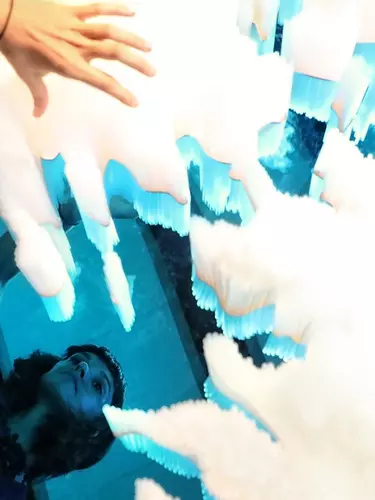Can 15,000 plastic straws be art?
Francesca Pasquali creates sculptures from the things we usually throw away
When I visualised 15,000 plastic straws (the amount ‘left over’ from the Opera House going plastic straw free in August 2018), I imagined that if I tipped them out they were going to fill my bath, or maybe even my car. Because 15,000 is a lot of ‘something’. I was surprised when I learnt that they were contained in several small battered cardboard boxes.
Your first reaction may have been like mine, which was to say, so 15,000 straws isn’t that much when you look at it; should we just focus on the symbolic message of the Opera House going plastic straw free? After all, the action in and of itself is important, and through our Environmental Sustainability Manager Emma Bombonato’s support of the then Deputy Lord Mayor Jess Miller’s ‘Sydney Doesn’t Suck’ campaign, the Opera House would save 2.2m straws annually from becoming waste.
Then I remembered that plastic straws can’t be recycled, and if we could find a creative way to give them a new life, we’d prevent these straws from ever ending up in the natural environment, creating something beautiful in the process. Never to shy away from such challenges, the Opera House was essentially built on finding creative solutions to a seemingly impossible problems; we looked to Utzon’s legacy to “work at the edge of the possible”, and that’s where this idea started.
A creative solution
You know it’s a special kind of project when elements come together quickly, and passionately. Together with Adobe, the Opera House wanted to imagine a creative solution where we could lead and inspire others to be more conscious of the sustainability challenges we face as a people. We all know the scary realities of what plastic is doing to our environment. I recently read that microplastics are now readily eaten by fish, and in some countries where people eat a lot of fish they’re consuming up to 246 pieces of microplastics a year. Then there’s the Great Pacific Garbage Patch floating around, which is about the size of the state of NSW. It’s been getting out of control for years, and yet here we are still complaining about forgetting our canvas bags and ‘needing’ plastic bags.
Francesca Pasquali is an Italian experimental visual artist who has been grappling with this reality through her artwork for years. When we approached her with our challenge, she felt strongly we needed to “sensitize, educate and stimulate a conscious use of plastic materials” and to do this she was willing to participate with Opera House visitors to use all leftover straws and create an original work of art. Willing to donate the work to us, her one request was that we find a way to amplify the messages behind it through its public exhibition and storytelling online.

A sustainable legacy
Sustainability is a fundamental part of the Opera House. I love that fact that our air conditioning system uses the seawater from Sydney’s harbour in a non-impactful way to heat and cool the building, and that our one million ceramic tiles are self-cleaning. I love the fact that we took 15,000 unused plastic straws and commissioned Francesca to transform them into an arresting interpretation of Sydney Harbour, of which the Opera House is such an important part. It’s meta, but meaningful.
A few people raised concerns about the fact that we went single use plastic straw free, and these comments fell on pricked ears inside the Opera House. Their concerns are twofold, and join with voices from around the world. The first is that plastic straws make up around 4% of plastic waste in the world, and even less if you look at it by weight instead of volume. Their argument is, surely there were more impactful places for us to start than pesky plastic straws. The second concern came from people who have accessibility needs and require plastic straws who now feel singled out when visiting us. This was never our intention. . As a “community meeting place” we want to ensure that the Opera House is open and welcoming to everyone, which is why we continue to have plastic straws available to those who need them.
This project has taught us it’s easy to look past plastic waste, particularly when it’s small, and think there are bigger fish to fry. But it’s important for us all to take the first step towards sustainability and simply start somewhere. We hope this artwork inspires people to look twice at their own plastic waste and where they can, make a small change. Maybe even a creative one.
Plastic Islands will be on display for the general public in The Lounge, enabled by Samsung, from 17 September – 10 October.

